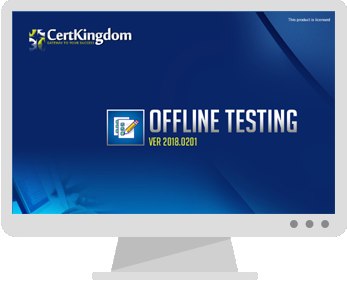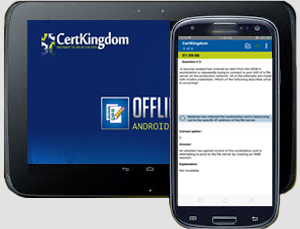Exam: MB2-876

|
|||||||||||||||||||||||||||
Certkingdom's preparation material includes the most excellent features, prepared by the same dedicated experts who have come together to offer an integrated solution. We provide the most excellent and simple method to pass your certification exams on the first attempt "GUARANTEED"
Whether you want to improve your skills, expertise or career growth, with Certkingdom's training and certification resources help you achieve your goals. Our exams files feature hands-on tasks and real-world scenarios; in just a matter of days, you'll be more productive and embracing new technology standards. Our online resources and events enable you to focus on learning just what you want on your timeframe. You get access to every exams files and there continuously update our study materials; these exam updates are supplied free of charge to our valued customers. Get the best MB2-876 exam Training; as you study from our exam-files "Best Materials Great Results"
MB2-876 Exam + Online / Offline and Android Testing Engine & 4500+ other exams included
$50 - $25 (you save $25)
Buy Now
Exam MB2-876:
Extending Microsoft Dynamics CRM 2011
Preparing for an Exam
This certification exam measures your ability to understand and articulate how to extend Microsoft Dynamics CRM 2011 including planning a Microsoft Dynamics CRM 2011 deployment, performing common and advanced platform operations, creating custom workflow activities, utilizing Windows Workflow Foundation, creating plug-ins, implementing and programming application events, customizing application integration, and implementing web resources.
Exam Topics Covered
The following list includes the topic areas covered on this exam.
Planning to Deploy Microsoft Dynamics CRM
Performing Common Platform Operations
Performing Advanced Platform Operations
Creating Custom Workflow Activities and Utilizing Windows Workflow Foundation
Creating Plug-ins
Implementing Application Events
Programming Application Events
Customizing Application Integration
Implementing Web Resources
Audience Profile
This exam is intended for individuals who plan to extend Microsoft Dynamics CRM 2011. This audience typically includes developers, business analysts, implementation consultants, technical staff, or support professionals.
Additional Skills Recommended:
General working knowledge of Microsoft Dynamics CRM 2011, including basic form customizations, web services, and workflows; .NET-connected applications in Microsoft Visual Studio, AJAX, DHTML, HTML, JScript, Microsoft SharePoint, Microsoft Silverlight, Transact - SQL, Windows Azure Platform, Windows Workflow Foundation, and XML.
Credit Toward Certification
When you pass Exam MB2-876: Extending Microsoft Dynamics CRM 2011, you complete the requirements for the following certification(s):
Microsoft Dynamics Certified Technology Specialist
This Training will cover
This exam measures your ability to accomplish the technical tasks listed below. The percentages indicate the relative weight of each major topic area on the exam. The higher the percentage, the more questions you are likely to see on that content area on the exam.
The information after “This objective may include but is not limited to” is intended to further define or scope the objective by describing the types of skills and topics that may be tested for the objective. However, it is not an exhaustive list of skills and topics that could be included on the exam for a given skill area. You may be tested on other skills and topics related to the objective that are not explicitly listed here.
Planning to Deploy Microsoft Dynamics CRM (11 percent)
Identify the layers in the Microsoft Dynamics CRM 2011 architecture.
This topic may include: Application layer; Platform layer; Database layer
Identify the deployment considerations.
This topic may include: describe the deployment model; identify support for Microsoft Outlook clients; identify the extensibility points; identify types of reporting; identify the web resources
Performing Common Platform Operations (12 percent)
Describe how to use IDiscoveryService.
This topic may include: what is the IDiscoveryService used for?
Describe how to use IOrganizationService.
This topic may include: what is the IOrganizationService used for?
Describe how to use early-bound entry classes.
This topic may include: what is a early-bound entry class used for?
Describe how to use late-bound entry classes.
This topic may include: what is a late-bound entry class used for?
Describe data types.
Describe how to use methods.
This topic may include: Create; Retrieve; Update; Delete; RetrieveMultiple
Describe how to handle SOAP exceptions.
Performing Advanced Platform Operations (12 percent)
Identify different ways to query data.
This topic may include: QueryExpression; QueryByAttribute; LINQ queries; FetchXML; filtered views
Save queries.
Identify how to use the Execute() method.
Identify how to use requests and responses.
Identify how to use late-bound vs. early-bound.
Identify how to use the Entity class.
Identify how to use the IOrganizationService web service.
Creating Custom Workflow Activities and Utilizing Windows Workflow Foundation (10 percent)
Describe process architecture.
Describe workflow.
This topic may include: actions and conditions; input arguments; variables
Describe dialog.
This topic may include: rules; events; pages; prompts and responses; actions and conditions
Set up custom workflow activity assemblies.
Create custom workflow activities.
Debug custom workflow activities.
Create and modify workflows in Windows Workflow Foundation.
Creating Plug-ins (11 percent)
Describe plug-ins.
This topic may include: what is a plug-in; when to use a plug-in; cascading events; information available in plug-ins; plug-ins and Microsoft Dynamics CRM 2011 for Microsoft Office Outlook
Describe event framework.
This topic may include: key features; event execution pipeline
Describe plug-in isolation, trusts, and statistics.
This topic may include: sandbox
Develop plug-ins.
This topic may include: data context; exception handling; impersonation; registration and deployment
Describe the Entity class and its uses.
Describe the integration of Windows Azure with Microsoft Dynamics CRM 2011.
This topic may include: overview of the Windows Azure platform; integration with Microsoft Dynamics CRM 2011; creation of a Listener for a Windows Azure solution; sending data over the AppFabric Service Bus; creating a Windows Azure–aware plug-in
Implementing Application Events (11 percent)
Describe the use of JScript web resources and how they are used for client-side events.
This topic may include: overview of web resources; reference web resources; use the Jscript web resource
Describe form and field events.
This topic may include: OnChange; OnLoad; OnSave; TabStateChange; OnReadyStateComplete
Describe form event handler execution context.
Set event dependencies.
Identify best practices in writing client-side code.
Debug client-side code.
Request external data.
Pass parameters.
Access Microsoft Dynamics CRM 2011 web services.
Programming Application Events (11 percent)
Describe form types.
Describe global variables and functions.
Implement Xrm.Page.context.
Implement Xrm.Page.data.entity.
Implement Xrm.Page.ui.
Implement GetGlobalContext.
Customizing Application Integration (11 percent)
Describe ways to customize the user interface.
Customize the site map XML.
Customize the ribbon XML.
Customize the form XML.
Describe how customizations impact Microsoft Outlook
Implement IFrames in entity forms.
This topic may include: describe IFrames considerations; retrieve data by using parameters; dynamic IFrame
Describe URL-addressable forms and views.
Describe application integration with Microsoft SharePoint Server.
Implementing Web Resources (11 percent)
Implement webpage (HTML) web resources.
This topic may include: creation; limitations; passing parameters
Implement data (XML) web resources.
This topic may include: creation; limitations; referencing
Implement style sheet (CSS) web resources.
This topic may include: creation; limitations; referencing
Implement style sheet (XSL) web resources.
This topic may include: creation; limitations; referencing
Implement image (PNG, JPG, GIF, ICO) web resources.
This topic may include: creation; limitations; referencing
Implement Silverlight (XAP) web resources.
This topic may include: creating Silverlight web resources; accessing context data; passing data to a Silverlight web resource; using the REST endpoint; testing and debugging
Make yourself more valuable in today's competitive computer industry Certkingdom's preparation material includes the most excellent features, prepared by the same dedicated experts who have come together to offer an integrated solution. We provide the most excellent and simple method to pass your Microsoft Microsoft CRM Exams MB2-876 exam on the first attempt "GUARANTEED".
Unlimited Access Package
will prepare you for your exam with guaranteed results, MB2-876 Study Guide. Your exam will download as a single MB2-876 PDF or complete MB2-876 testing engine as well as over +4000 other technical exam PDF and exam engine downloads. Forget buying your prep materials separately at three time the price of our unlimited access plan - skip the MB2-876 audio exams and select the one package that gives it all to you at your discretion: MB2-876 Study Materials featuring the exam engine.
Certkingdom MB2-876 Exam Prepration Tools
Certkingdom Microsoft Microsoft CRM Exams preparation begins and ends with your accomplishing this credential goal. Although you will take each Microsoft Microsoft CRM Exams online test one at a time - each one builds upon the previous. Remember that each Microsoft Microsoft CRM Exams exam paper is built from a common certification foundation.
MB2-876 Exam Testing Engines
Beyond knowing the answer, and actually understanding the MB2-876 test questions puts you one step ahead of the test. Completely understanding a concept and reasoning behind how something works, makes your task second nature. Your MB2-876 quiz will melt in your hands if you know the logic behind the concepts. Any legitimate Microsoft Microsoft CRM Exams prep materials should enforce this style of learning - but you will be hard pressed to find more than a Microsoft Microsoft CRM Exams practice test anywhere other than Certkingdom.
MB2-876 Exam Questions and Answers with Explanation
This is where your Microsoft Microsoft CRM Exams MB2-876 exam prep really takes off, in the testing your knowledge and ability to quickly come up with answers in the MB2-876 online tests. Using Microsoft CRM Exams MB2-876 practice exams is an excellent way to increase response time and queue certain answers to common issues.
MB2-876 Exam Study Guides
All Microsoft Microsoft CRM Exams online tests begin somewhere, and that is what the Microsoft Microsoft CRM Exams training course will do for you: create a foundation to build on. Study guides are essentially a detailed Microsoft Microsoft CRM Exams MB2-876 tutorial and are great introductions to new Microsoft Microsoft CRM Exams training courses as you advance. The content is always relevant, and compound again to make you pass your MB2-876 exams on the first attempt. You will frequently find these MB2-876 PDF files downloadable and can then archive or print them for extra reading or studying on-the-go.
MB2-876 Exam Video Training
For some, this is the best way to get the latest Microsoft Microsoft CRM Exams MB2-876 training. However you decide to learn MB2-876 exam topics is up to you and your learning style. The Certkingdom Microsoft Microsoft CRM Exams products and tools are designed to work well with every learning style. Give us a try and sample our work. You'll be glad you did.
MB2-876 Other Features
* Realistic practice questions just like the ones found on certification exams.
* Each guide is composed from industry leading professionals real Microsoft Microsoft CRM Examsnotes, certifying 100% brain dump free.
* Study guides and exam papers are guaranteed to help you pass on your first attempt or your money back.
* Designed to help you complete your certificate using only
* Delivered in PDF format for easy reading and printing Certkingdom unique CBT MB2-876 will have you dancing the Microsoft Microsoft CRM Exams jig before you know it
* Microsoft CRM Exams MB2-876 prep files are frequently updated to maintain accuracy. Your courses will always be up to date.
Get Microsoft CRM Exams ebooks from Certkingdom which contain real MB2-876 exam questions and answers. You WILL pass your Microsoft CRM Exams exam on the first attempt using only Certkingdom's Microsoft CRM Exams excellent preparation tools and tutorials.
These are real testimonials. Hi friends! CertKingdom.com is No1 in sites coz in $50 I cant believe this but when I purchased the $50 package it was amazing I Microsoft passed 10 Exams using CertKingdom guides in one Month So many thanks to CertKingdom Team , Please continue this offer for next year also. So many Thanks
Mike CA
Thank You! I would just like to thank CertKingdom.com for the Microsoft Microsoft CRM Exams MB2-876 test guide that I bought a couple months ago and I took my test and pass overwhelmingly. I completed the test of 181 questions in about 90 minutes I must say that their Q & A with Explanation are very amazing and easy to learn.
Jay Brunets
After my co-workers found out what I used to pass Microsoft Microsoft CRM Exams MB2-876 the test, that many are thinking about purchasing CertKingdom.com for their Microsoft CRM Exams exams, I know I will again
John NA
I passed the Microsoft Microsoft CRM Exams MB2-876 exam yesterday, and now it's on to security exam. Couldn't have done it with out you. Thanks very much.
Oley R.
Hello Everyone
I Just Passed The Microsoft Microsoft CRM Exams MB2-876 Took 80 to 90 Minutes max to understand and easy to learn. Thanks For Everything Now On To MB2-876
Robert R.
Hi CertKingdom.com thanks so much for your assistance in Microsoft Microsoft CRM Exams i passed today it was a breeze and i couldn't have done it without you. Thanks again
Seymour G.
I have used your Exam Study Guides for preparation for Microsoft Microsoft CRM Exams MB2-876. I also passed all those on the first round. I'm currently preparing for the Microsoft and theMicrosoft CRM Exams. exams
Ken T.
I just wanted to thank you for helping me get myMicrosoft CRM Exams $50 package for all guides is awesome you made the journey a lot easier. I passed every test the first time using your Guide
Mario B.
I take this opportunity to express my appreciation to the authors of CertKingdom.com Microsoft Microsoft CRM Exams test guide. I purchased the MB2-876 soon after my formal hands on training and honestly, my success in the test came out of nowhere but CertKingdom.com. Once again I say thanks
Kris H.
Dear CertKingdom.com team the test no. MB2-876 that i took was very good, I received 880 and could have gain more just by learning your exams
Gil L.
Hi and Thanks I have just passed the Microsoft CRM Exams Directory Services Design exam with a score of 928 thanks to you! The guide was excellent
Edward T.
Great stuff so far....I love this site....!! I am also on the Microsoft Microsoft CRM Exams I decided to start from certkingdom and start learning study Microsoft CRM Exams from home... It has been really difficult but so far I have managed to get through 4 exams....., now currently studying for the more exams.... Have a good day.................................................. Cheers
Ted Hannam
Thanks for your Help, But I have finally downloaded Microsoft Microsoft CRM Exams MB2-876 exam preparation from certkingdom.com they are provided me complete information about the exam, lets hope I get success for the MB2-876 exam, I found there exams very very realistic and useful. thanks again
lindsay Paul
Certkingdom Offline Testing Engine Simulator Download
Prepare with yourself how CertKingdom Offline Exam Simulator it is designed specifically for any exam preparation. It allows you to create, edit, and take practice tests in an environment very similar to an actual exam.
Supported Platforms: Windows-7 64bit or later - EULA | How to Install?
FAQ's: Windows-8 / Windows 10 if you face any issue kinldy uninstall and reinstall the Simulator again.
Download Offline Simulator-Beta
Certkingdom Testing Engine Features
- Certkingdom Testing Engine simulates the real exam environment.
- Interactive Testing Engine Included
- Live Web App Testing Engine
- Offline Downloadable Desktop App Testing Engine
- Testing Engine App for Android
- Testing Engine App for iPhone
- Testing Engine App for iPad
- Working with the Certkingdom Testing Engine is just like taking the real tests, except we also give you the correct answers.
- More importantly, we also give you detailed explanations to ensure you fully understand how and why the answers are correct.
Certkingdom Android Testing Engine Simulator Download
Take your learning mobile android device with all the features as desktop offline testing engine. All android devices are supported.
Supported Platforms: All Android OS EULA
Install the Android Testing Engine from google play store and download the app.ck from certkingdom website android testing engine download

Certkingdom Android Testing Engine Features
- CertKingdom Offline Android Testing Engine
- Make sure to enable Root check in Playstore
- Live Realistic practice tests
- Live Virtual test environment
- Live Practice test environment
- Mark unanswered Q&A
- Free Updates
- Save your tests results
- Re-examine the unanswered Q & A
- Make your own test scenario (settings)
- Just like the real tests: multiple choice questions
- Updated regularly, always current




